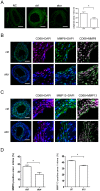Atorvastatin improves plaque stability in ApoE-knockout mice by regulating chemokines and chemokine receptors
- PMID: 24816562
- PMCID: PMC4016207
- DOI: 10.1371/journal.pone.0097009
Atorvastatin improves plaque stability in ApoE-knockout mice by regulating chemokines and chemokine receptors
Abstract
It is well documented that statins protect atherosclerotic patients from inflammatory changes and plaque instability in coronary arteries. However, the underlying mechanisms are not fully understood. Using a previously established mouse model for vulnerable atherosclerotic plaque, we investigated the effect of atorvastatin (10 mg/kg/day) on plaque morphology. Atorvastatin did not lower plasma total cholesterol levels or affect plaque progression at this dosage; however, vulnerable plaque numbers were significantly reduced in the atorvastatin-treated group compared to control. Detailed examinations revealed that atorvastatin significantly decreased macrophage infiltration and subendothelial lipid deposition, reduced intimal collagen content, and elevated collagenase activity and expression of matrix metalloproteinases (MMPs). Because vascular inflammation is largely driven by changes in monocyte/macrophage numbers in the vessel wall, we speculated that the anti-inflammatory effect of atorvastatin may partially result from decreased monocyte recruitment to the endothelium. Further experiments showed that atorvastatin downregulated expression of the chemokines monocyte chemoattractant protein (MCP)-1, chemokine (C-X3-C motif) ligand 1 (CX3CL1) and their receptors CCR2 and, CX3CR1, which are mainly responsible for monocyte recruitment. In addition, levels of the plasma inflammatory markers C-reactive protein (CRP) and tumor necrosis factor (TNF)-α were also significantly decrease in atorvastatin-treated mice. Collectively, our results demonstrate that atorvastatin can improve plaque stability in mice independent of plasma cholesterol levels. Given the profound inhibition of macrophage infiltration into atherosclerotic plaques, we propose that statins may partly exert protective effects by modulating levels of chemokines and their receptors. These findings elucidate yet another atheroprotective mechanism of statins.
Conflict of interest statement
Figures




Similar articles
-
Atorvastatin inhibits plaque development and adventitial neovascularization in ApoE deficient mice independent of plasma cholesterol levels.Atherosclerosis. 2011 Feb;214(2):295-300. doi: 10.1016/j.atherosclerosis.2010.11.008. Epub 2010 Nov 13. Atherosclerosis. 2011. PMID: 21130458
-
In vivo fluorescence-mediated tomography imaging demonstrates atorvastatin-mediated reduction of lesion macrophages in ApoE-/- mice.Anesthesiology. 2013 Jul;119(1):129-41. doi: 10.1097/ALN.0b013e318291c18b. Anesthesiology. 2013. PMID: 23559030
-
The complementary effects of atorvastatin and exercise treatment on the composition and stability of the atherosclerotic plaques in ApoE knockout mice.PLoS One. 2014 Sep 29;9(9):e108240. doi: 10.1371/journal.pone.0108240. eCollection 2014. PLoS One. 2014. PMID: 25264981 Free PMC article. Clinical Trial.
-
99mTc-Monocyte chemoattractant protein-1.2008 Feb 2 [updated 2008 Mar 26]. In: Molecular Imaging and Contrast Agent Database (MICAD) [Internet]. Bethesda (MD): National Center for Biotechnology Information (US); 2004–2013. 2008 Feb 2 [updated 2008 Mar 26]. In: Molecular Imaging and Contrast Agent Database (MICAD) [Internet]. Bethesda (MD): National Center for Biotechnology Information (US); 2004–2013. PMID: 20641934 Free Books & Documents. Review.
-
New insights in statins affecting atheromatous plaque macrophages.Curr Opin Lipidol. 2021 Aug 1;32(4):258-264. doi: 10.1097/MOL.0000000000000769. Curr Opin Lipidol. 2021. PMID: 34054106 Review.
Cited by
-
Protective effects of quercetin and taraxasterol against H2O2-induced human umbilical vein endothelial cell injury in vitro.Exp Ther Med. 2015 Oct;10(4):1253-1260. doi: 10.3892/etm.2015.2713. Epub 2015 Aug 25. Exp Ther Med. 2015. PMID: 26622474 Free PMC article.
-
NR4A1 deficiency promotes carotid plaque vulnerability by activating integrated stress response via targeting Bcat1.Cell Mol Life Sci. 2025 Feb 22;82(1):91. doi: 10.1007/s00018-025-05602-2. Cell Mol Life Sci. 2025. PMID: 39985585 Free PMC article.
-
Plasma APE1/Ref-1 Correlates with Atherosclerotic Inflammation in ApoE-/- Mice.Biomedicines. 2020 Sep 21;8(9):366. doi: 10.3390/biomedicines8090366. Biomedicines. 2020. PMID: 32967121 Free PMC article.
-
Regulatory effects of statins on CCL2/CCR2 axis in cardiovascular diseases: new insight into pleiotropic effects of statins.J Inflamm (Lond). 2024 Dec 18;21(1):51. doi: 10.1186/s12950-024-00420-y. J Inflamm (Lond). 2024. PMID: 39696507 Free PMC article.
-
Cytokines: roles in atherosclerosis disease progression and potential therapeutic targets.Future Med Chem. 2016 Jul;8(11):1317-30. doi: 10.4155/fmc-2016-0072. Epub 2016 Jun 30. Future Med Chem. 2016. PMID: 27357616 Free PMC article. Review.
References
-
- Momi S, Monopoli A, Alberti PF, Falcinelli E, Corazzi T, et al. (2012) Nitric oxide enhances the anti-inflammatory and anti-atherogenic activity of atorvastatin in a mouse model of accelerated atherosclerosis. Cardiovasc Res 94: 428–438. - PubMed
-
- Cho KY, Miyoshi H, Kuroda S, Yasuda H, Kamiyama K, et al. (2013) The phenotype of infiltrating macrophages influences arteriosclerotic plaque vulnerability in the carotid artery. J Stroke Cerebrovasc Dis 22: 910–918. - PubMed
-
- Shen LH, Zhou L, Wang BY, Pu J, Hu LH, et al. (2008) Oxidized low-density lipoprotein induces differentiation of RAW264.7 murine macrophage cell line into dendritic-like cells. Atherosclerosis 199: 257–264. - PubMed
-
- Hu LH, Zhang T, Shao Q, Li DD, Jin SX, et al. (2012) Atorvastatin suppresses oxidized LDL-induced dendritic cell-like differentiation of RAW264.7 cells regulated by the p38 MAPK pathway. Mol Cell Biochem 371: 105–113. - PubMed
Publication types
MeSH terms
Substances
LinkOut - more resources
Full Text Sources
Other Literature Sources
Molecular Biology Databases
Research Materials
Miscellaneous

